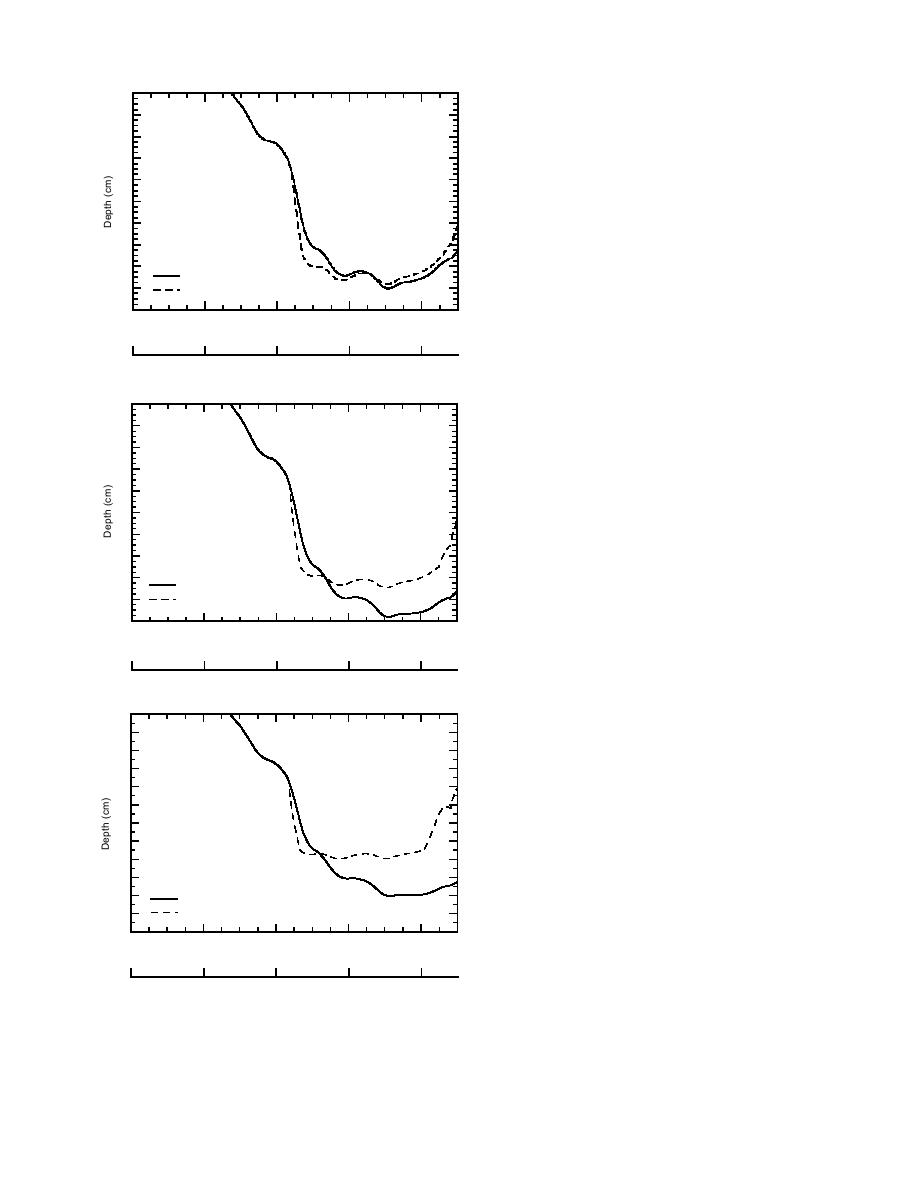
0
of the freezing front from 15- to 30-cm depth. A
smaller change in heat content is required to re-
duce the temperature of and eventually freeze
8
the sand.
Whether frost penetration below the sand in-
16
clusion occurs is the net result of the diminished
cooling from the surface downward and further
24
warming of the basal soil due to heat flow from
depth. As discussed above, when there is no
sand inclusion, frost penetration proceeds more
32
No Sand
slowly below 30 cm because of the overall warm-
Sand
ing trend at the surface. There is also heat flow
40
from the warm soil at depth, as defined by the
0
40
80
120
160
initial temperature condition (Fig. 2). After that
Day (22 Oct is day 1)
heat has been conducted through the soil below
21 Oct
30 Nov
9 Jan
18 Feb
30 March
the sand inclusion, at a rate determined by the
a. 10% moisture content.
thermal properties of unfrozen soil, its upward
0
flow is retarded by the low thermal conductivity
of the frozen sand; therefore, more heat is re-
tained in the soil at the base of the sand inclusion
8
and it warms. Further frost penetration is inhibit-
ed by the resistance to upward heat flow caused
16
by the presence of the sand inclusion. Frost
depth is least in the soil with the highest mois-
ture content (Fig. 14) because a reduction in tem-
24
perature of that soil requires the largest change
in thermal energy, and so is most impeded by
32
warming of the soil as a consequence of the pres-
No Sand
Sand
ence of the sand inclusion. The inclusion is like a
layer of insulation at this stage, impeding the
40
0
40
80
120
160
heat flow towards the ground surface that fur-
Day (22 Oct is day 1)
ther freezing requires. A consequence of this is
that 17 and 25% moisture content soil at 37.5-cm
21 Oct
30 Nov
9 Jan
18 Feb
30 March
depth remains above freezing when the sand in-
b. 17% moisture content.
clusion is present (Table 4). Maximum frost pene-
0
tration (Table 3) is ∼3 cm deeper in the relatively
dry soil (10% moisture content) than it is in the
8
wettest soil (25% moisture content).
For BC-Warm winters, the advantage for sen-
16
sor system performance of having a sand inclu-
sion present is related to soil temperature, not
24
frost depth, since the soil above a sensor cable
(22.5-cm depth) freezes in both cases. When an
32
inclusion is present, the frozen soil is colder (Ta-
ble 4). Although the temperature difference is
40
No Sand
small, ∼0.5C, the soil temperature is in the range
Sand
(0 to 3.5C) where a small change in tempera-
48
0
40
80
120
160
ture can result in an appreciable change in unfro-
Day (22 Oct is day 1)
zen moisture content (Williams 1967, Anderson
and Morgenstern 1973).
21 Oct
30 Nov
9 Jan
18 Feb
30 March
The disadvantage of having a sand inclusion
c. 25% moisture content.
under BC-Warm conditions is that there can be a
Figure 13. Comparison of the location of the freezing front
large relative decrease in frost depth beneath the
in silty soil with and without a sand inclusion present, as
inclusion. Frost depth is 6 cm (14%) or 8 cm
determined with one-dimensional numerical simulations
(20%) less in 17% or 25% moisture content soil,
under BC-Warm conditions.
14



 Previous Page
Previous Page
